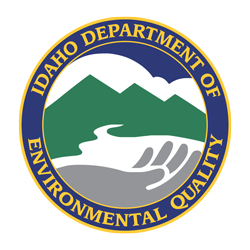| Data | Details |
|---|---|
| Hydrologic Unit Codes | 17040221 |
| Size | 1,132 square miles (724,480 acres) |
| Water Bodies with EPA-Approved TMDLs (Category 4a) | Dry Creek, Fish Creek, Little Wood River, Muldoon Creek, Silver Creek |
| Beneficial Uses Affected | Cold water aquatic life, salmonid spawning, secondary contact recreation |
| Major Land Uses | Range, agriculture, forest |
| Addendum Approved by EPA | September 2005 EPA Approval Letter |
Subbasin Characteristics
The Little Wood River subbasin lies in south-central Idaho. The river originates in the Pioneer Mountains of the Sawtooth National Forest and discharges in the desert plains at the Big Wood River.
2005 Subbasin Assessment and TMDL
Nutrients were measured in the form of total phosphorus and total inorganic nitrogen. High annual averages of total inorganic nitrogen, combined with elevated total phosphorus levels, indicate that nutrients could be at levels capable of contributing to nuisance aquatic growth. Nutrient TMDLs have been completed for Fish Creek (both above and below Fish Creek Reservoir) and for the Little Wood River from Silver Creek to the Big Wood River.
Sediment was measured in the water column as total suspended solids and as percent fines. Where percent fines were elevated, streambank erosion inventories were completed to determine if streambanks were the source of sediment. Streambank erosion TMDLs for sediment were completed on Dry Creek, both segments of Fish Creek, and the Little Wood River from Silver Creek to the Big Wood River.
Bacteria and temperature both have numeric water quality standards and, as such, have numeric values that have to be met. Where numeric bacteria standards were exceeded, additional samples were collected; a bacteria TMDL was completed for Fish Creek above Fish Creek Reservoir. Where water temperatures were elevated, the canopy cover of the water bodies was measured to develop TMDLs. Temperature TMDLs were completed on Loving Creek, Muldoon Creek, both segments of Fish Creek, and the Little Wood River.
Flow alteration has been identified as pollution for many of the water bodies. However, the US Environmental Protection Agency does not consider flow alteration as a pollutant as defined by the Clean Water Act. Since TMDLs are not required for water bodies impaired by pollution but not pollutants, TMDLs were not developed for flow alteration. The water bodies with flow alteration have been identified as such and put on a list of water bodies impaired by pollution.
Where biological and water chemistry data indicated that beneficial uses were being fully supported, those water bodies were proposed for removal from the §303(d) list. Both Fish Creek Reservoir and Little Wood River Reservoir were recommended for removal.
2005 TMDL: Streams and Pollutants for Which TMDLs Were Developed
| Stream | Pollutants |
|---|---|
| Little Wood River (headwaters to reservoir) | Temperature |
| Little Wood River (Silver Creek to Big Wood River) | Sediment, nutrients, temperature |
| Fish Creek (above Fish Creek Reservoir) | Sediment, nutrients, bacteria, temperature |
| Fish Creek (below Fish Creek Reservoir) | Sediment, nutrients, temperature |
| Dry Creek | CreekSedimentMuldoon |
| Muldoon Creek | Temperature |
| Loving Creek | Temperature |

